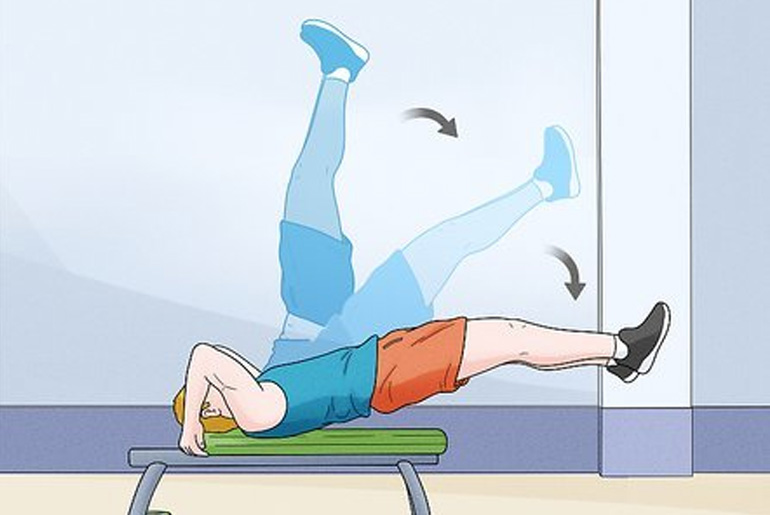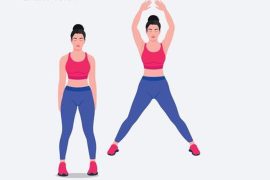Core-strengthening exercises like leg raises, crunches, and planks are great for building a strong midsection. However, if you’re looking for a greater challenge, the dragon flag exercise is an advanced move worth trying. Made famous by martial arts legend Bruce Lee, the dragon flag is a full-body workout that primarily targets the core while also improving flexibility and overall strength. Due to its demanding nature, it is best suited for individuals with a strong foundation in core training. Beginners should first master simpler exercises like crunches and planks before attempting this highly challenging movement.
Dragon Flag Exercise
The dragon flag is a challenging bodyweight exercise that primarily targets the core muscles while also engaging the glutes, shoulders, and overall body stability. To perform this move, you lie on your back and grip a firm surface for support. Then, you lift your entire body off the ground, keeping it straight from shoulders to toes, resembling a flag on a pole. The key challenge lies in maintaining control while raising and lowering your body, requiring significant core strength and stability. As an advanced-level exercise, the dragon flag is ideal for those looking to develop exceptional abdominal strength and full-body control.
Muscles Engaged While Performing the Dragon Flag Exercise
The dragon flag is a full-body movement that primarily targets the core muscles but also engages various stabilizing muscles.
1. Core Muscles
According to 2020 research published in the International Journal of Environmental Research and Public Health, the core is like an anatomical box made up of multiple muscle groups:
- Rectus Abdominis – The six-pack muscles that help maintain core stability.
- Internal and External Obliques – Assist in rotational control and stabilization.
- Erector Spinae – Supports spinal alignment and back stability.
- Lumbar Multifidus – Small deep muscles that contribute to spinal support.
- Quadratus Lumborum – Helps maintain lower back stability.
2. Hip Flexors
Iliopsoas and Rectus Femoris – Aid in lifting and lowering the legs.
3. Glutes and Hamstrings
Gluteus Maximus and Hamstrings – Act as stabilizers to prevent the lower body from sagging.
4. Shoulders and Upper Body
Arms, Chest, and Shoulders – Engage when gripping the bench, providing stability and control during the movement.
By activating these major muscle groups, the dragon flag is one of the most challenging and rewarding exercises for core and full-body strength!
Benefits of the Dragon Flag Exercise
- Strengthens Your Core: The dragon flag is one of the most effective exercises for building core strength. It engages the rectus abdominis, obliques, and lower back muscles, helping to develop a strong and well-rounded core.
- Better Stability and Balance: Holding the body in a straight line while lowering and raising it demands significant balance and control. This improves overall stability, reducing the risk of injuries in daily movements and sports activities.
- Increases Flexibility: Despite being a strength-based movement, the controlled lowering and raising motion helps stretch the spine and hamstrings, improving flexibility and mobility over time.
- Engages Your Full Body: While it is a core-dominant movement, the dragon flag also activates the shoulders, chest, arms, glutes, and legs, making it an effective full-body workout that enhances muscle tone and strength.
- Improves Mental Toughness: This exercise requires intense focus and control, especially for multiple repetitions. Performing the dragon flag consistently builds mental discipline and perseverance, which can benefit other workouts and daily challenges.
- May Reduce Back Pain: Strong core muscles provide better support for the lower back, reducing strain and discomfort. Studies suggest that core strength training is more effective than general exercise in alleviating low back pain, making the dragon flag a valuable addition to a fitness routine.
This challenging move offers a combination of strength, flexibility, and endurance, making it a great addition to any advanced workout regimen!
How to Perform the Dragon Flag Exercise
- Find a Solid Support: Use a bench, horizontal bar, or any sturdy surface you can grip firmly.
- Get into Position: Lie flat on your back with your head and neck in a neutral position. Place your hands on the side of the bench for stability.
- Engage Your Core: Lift your legs off the ground while keeping them straight. Swing your legs over your torso in a straight line.
- Control Your Movement: Raise your entire body vertically, keeping your legs and torso aligned. Your body should be as rigid as a flag on a pole.
- Lower Yourself Slowly: Maintain control as you descend slowly, keeping your core engaged. Avoid sudden drops to prevent injury.
- Repetitions and Sets: Aim for 3 sets of 10 to 15 reps, depending on your strength level.
Who Should Avoid the Dragon Flag Exercise?
- People with Spine Problems – The exercise places high stress on the lower back and can worsen existing conditions.
- Beginners – It requires significant core strength, so start with simpler exercises like leg raises or planks first.
- Pregnant Women – Puts excessive pressure on the abdomen, which may not be safe.
Since the dragon flag is an advanced movement, it’s essential to assess your fitness level before attempting it. Prioritize proper form and control to maximize benefits while preventing injuries.
Disclaimer:
The information contained in this article is for educational and informational purposes only and is not intended as a health advice. We would ask you to consult a qualified professional or medical expert to gain additional knowledge before you choose to consume any product or perform any exercise.






